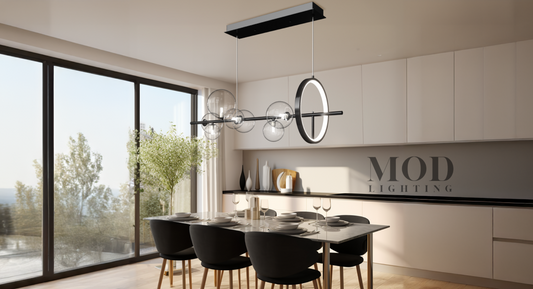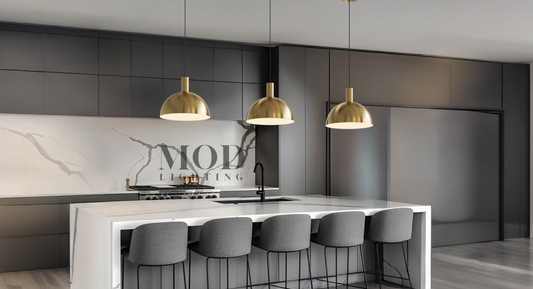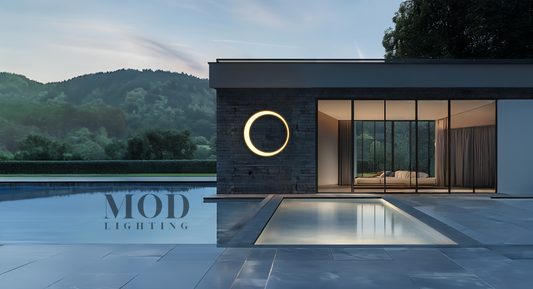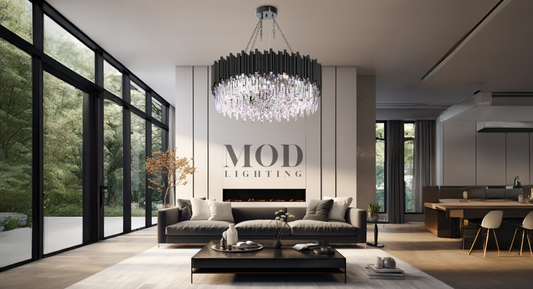Electric lighting has come a long way since Sir Humphry Davy, a British chemist, invented the world’s first proof of concept in the arc lamp. The arc lamp was the best of the best in its time, much like LED bulbs are the best of our time.
Although the arc lamp’s physical light dimmed rather quickly, its metaphorical light lit the path for scientists and inventors of the future to experiment with and improve upon Davy’s successes.
Today, there are four main categories of bulbs: fluorescent bulbs (both standard and “CFL” or compact fluorescent exist, but CFLs are more common), incandescent bulbs (which include vintage/decorative “Edison” light bulbs), halogen bulbs, and LED bulbs.
This article will discuss LED bulbs in detail, including an explanation of what LEDs are, what they are used for, advantages of LED lights, and things to look out for when purchasing LEDs. In other words, if you’ve ever asked yourself, “why are LED lights better than others?” this article is for you.
What are LEDs?
Light emitting diodes (LEDs) are a type of semiconductor, a piece of technology that enables applied electric currents to pass through its components, releasing energy as light in the process. They come in a variety of forms, materials, and sizes, and the possible use cases are endless.
What are LEDs used for?
Since LEDs produce most of their energy in the form of light and do so especially well, individuals and organizations alike are quickly turning to LEDs as their preferred lighting solution. Consumers frequently light their homes, garages, and shops with LEDs, especially when it comes time to replace older bulbs. Consumer products, such as cars and refrigerators, have begun incorporating LEDs as a selling point.
As for businesses, LEDs are no less popular. Common commercial uses include (but are not limited to):
- Street lights
- Parking lot and/or garage lighting
- Walkway lighting
- Outdoor area lighting
- Factories
- Office spaces
The Advantages of LED Lights
1. Safety
One of the top benefits of LED light bulbs—if not the top benefit—is safety.
Halogen and incandescent bulbs generate most of their energy output into heat, which increases the potential for fire hazards. CFLs produce about half of the heat but also contain small amounts of toxic chemicals and must be disposed of responsibly.
LEDs, on the other hand, produce about a fourth of the heat that incandescent bulbs do and their levels of toxic substances are far lower than those of CFLs (meaning LED bulbs can safely be thrown out with the rest of your trash).
Also, one used to worry about severely harmful or even fatal electric shocks if living in a flood zone because most lighting required electric systems to have high voltage. LEDs require about a tenth of the voltage of previous systems, which means that in the event of a crisis, they are less likely to electrocute you.
And finally, the minuscule amount of UV radiation that comes from LEDs is instantly converted to white light within the lamp. This means no eye or skin damage from UV rays, no ruined carpets or furniture, and no spoiled art pieces.
2. Energy Efficiency
The most often touted of LED lights advantages is how efficiently they run. LEDs produce eighty to ninety percent of their energy as light (which is the point, right?) and very little as heat, unlike their counterparts, whose thermal energy outputs equate to fifty percent or more. To show a direct comparison of energy efficiency, we’ve created a table below:

Efficient energy means less greenhouse gas emissions and more in-pocket savings (including lower utility bills and less repair/maintenance costs), whether the lights are on for longer or not.
3. Illumination
As can be seen in our table under “Energy Efficiency,” LED bulbs are able to produce bright light with less electricity usage. Note that the table directly compares total lumens and not actual delivered lumens. LEDs are more capable of delivering brighter light because their light is directional (180° vs. their counterparts’ 360° emissions).
Should we actually need even brighter lights in the future, LEDs could easily be adapted to produce even more light than the general amount homes and businesses typically require at present. And beyond producing bright light, research is being done to see if technological improvements to LEDs can solve Seasonal Affective Disorder (SAD) and other mental illnesses.
4. Lifespan
Energy efficiency also has a direct impact on the rated life bulbs have. Here is another table that covers the average rated life for each of the four bulb types we’ve mentioned here, both in hours and years of use:

One thing that helps LEDs have a longer lifespan is that unlike their traditional counterparts, LEDs produce light instantly, no warm-up period required. This means they can withstand rapid cycling—those moments when little ones repeatedly flip light switches on and off.
5. Versatility
These semiconductors themselves are actually quite small, which makes them perfect for adapting to a variety of situations. Applicable use cases range from circuit board indicator lights to Christmas tree lighting to an entire hangar or airway at an airport! Whether you use just one or group them to make larger light(s), LEDs are the swiss army knife of lighting.
6. Smart features
Among all the advantages of LED lights, perhaps the most sought after in recent years is the unparalleled access they offer in light control. The catch is you have to purchase specific smart-enabled bulbs, but once you have, there are so many possibilities.
For instance, some LEDs allow you to change anywhere between five and 100% of the total light capacity. Others allow you to change their color output (after all, the white light often produced by LEDs is in actuality a combination of multiple light waves in various colors). Most provide greater security and convenience through scheduled on-off times, voice control, and/or motion control features.
Yes, other types of bulbs allow you to dim them, but the lifespan and efficiency of these other bulbs is directly and negatively impacted by how dim they go. By contrast, the lifespan and efficiency of LEDs increase when they dim. The only drawback is that you have to have specific hardware that corresponds with the technology, but this is becoming less and less of a problem as LED technology develops further.
7. Weather tolerance
All LEDs need to get going is electricity (unlike traditional alternatives, which have to warm up before they can produce their brightest light. Without getting overly scientific, LEDs don’t produce much heat. This is good, because heat can damage bulb performance and lifespan over time. In colder temperatures, if your LEDs are flickering, it’s because something within has frozen (most common if you buy an off-brand or “value” LED bulb).
As for using LEDs in hot temperatures, their lifespan and overall brightness will decrease at a more rapid rate because the internal components cannot dissipate the heat as quickly as they would in cooler and cold temperatures. This in turn degrades the LEDs faster and makes them perform less well—but keep in mind that the same is true of traditional light bulbs as well.
8. Durability
LEDs don’t require filaments or glass like other bulbs do, so their performance and structure will not be impacted by vibration, shock, and physical impact from other objects. Even when dropped, LED bulbs are far less likely to shatter because they can and often do incorporate more durable materials at a lower cost (with prices ever decreasing as popularity rises and tech improvements continue).
9. Color temperature
Previously, LED bulbs were only available in harsh, cold whites, which was not conducive for studying or relaxing at home. Many people wrongly believe that this is still the case today, but LED technology has grown dramatically since the early days. Note that the majority of LED bulbs fall within these four temperature ranges (measured in Kelvin, but outliers do exist:
- Extra warm white (1,700-2,700K)
- Warm white (2,700-3,300K)
- Cool white (4,200-4,500K)
- Daylight white (5,500-7,000K)
Determining which specific temperature you will need for a given room is based upon the room’s purpose, your personal preferences, and whether you need to match existing bulbs. If you want to change the effect the light has on a room, switching up the color temperature of your bulbs is recommended.
10. Color Rendering Index (CRI) ratings
CRI ratings tell you how accurately your light will portray the true appearance of colors when compared to natural lighting. CRI ranges from zero to one hundred. The lower the CRI, the more washed-out colors will appear under your lights. The higher the CRI, the more animated colors will appear in your home or office. The great news here is that LEDs often rate very high on the CRI scale (usually between 65 and 95).
Typically, ratings above seventy-five are most acceptable because they render colors decently enough for most work that needs to be done. If lighting aesthetics are absolutely crucial to a location, however, such as hospital operating rooms, printing facilities, photography studios and more, you’ll want to rate above ninety.
Things to watch out for when purchasing LED lights
1. Initial investment is costly
While it’s true that the cost savings of LEDs over time is incredibly high when compared to traditional lighting solutions, they do have a much higher implementation cost initially—and especially if you’re replacing them all at once as opposed to when they burn out individually.
Also, even though it’s tempting to buy cheaper LED bulbs, you’ll be better off in the long term to purchase from trusted brands such as GE or Phillips. True, buying from “value” brands can cut costs significantly, but if designed poorly, the bulbs will wear down faster, flicker, change color, dim, or have uneven light. For most, this makes the initial investment more than worth it.
2. Repairability
Currently, most LED manufacturers design and construct bulbs and related fixtures in house since the whole package is a bit complex to work with. This means that if even one singular component fails to work, the whole unit must be replaced, which is costly both to consumers and to the environment.
As LED technology continues to progress, however, (as tech is prone to do) we are likely to see a greater call for LED standardization, especially since the rising generations emphasize going green and sustainability for years to come.
The final word on the advantages of LED lights
Now that you know the advantages of LED lights and a few pitfalls to watch out for when purchasing LED lights, you should feel confident to select the right lighting solutions for your home or office. LEDs are great for future proofing your home, especially if you get third generation LED bulbs. No matter which benefits interest you most, LEDs are here to stay and are a fantastic lighting solution that will save you energy, time, and money for years to come.
 OPEN BOX
OPEN BOX








